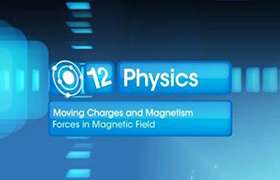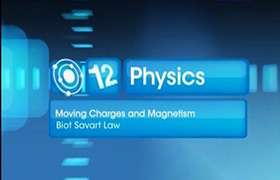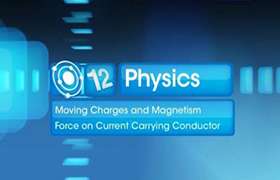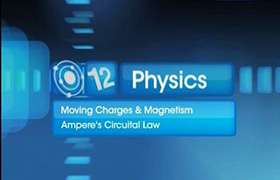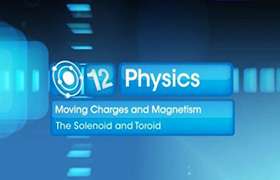CBSE Class 12-science Answered
The magnetic field at a point near the centre but outside a current carrying solenoid is zero. Explain why?
Asked by Monojit Saha | 27 May, 2013, 08:10: PM
In reality, the magnetic field outside a solenoid is never 0. But ideally speaking,Ampere's law shows that magnetic fields outside a solenoid should be 0.
1. Approach from Biot-Savart's Law:
Imagine a solenoid with a circular cross section. Pick a point on the circle (let this point be denoted P). And there is a magnetic field just immediately outside (let this location outside be denoted r) due to the current on that point. Other points on the circle contribute to magnetic fields at r as well. But unfortunately, because of the symmetry of the circle, the contributions of other points get cancelled. The point at the opposite side (let this point be denoted K) to P on the circle, adds a destructive contribution to the magnetic field due to point P. Of course, the contribution due to K is smaller than that due to P. But for an ideal solenoid, the radius of the circular cross section is assumed very small. So magnetic fields due to P and K should cancel each other out.
2. Approach from Ampere's Law:
When we have a solenoid, we assume that the magnetic fields inside the solenoid are uniform and pointing in the direction perpendicular to the cross section. Let the axis of the solenoid be in the z direction. You draw a line starting from a point A inside the solenoid to a point B along the z direction. Now you draw a line starting from B to a point C outside the solenoid such that BC and AB are perpendicular. Now you draw a line perpendicular to BC starting from C to D in the negative z direction such that the lengths AB and CD are equal. Now connect the points D and A to form a loop.
Ampere's Law says the line integral along the loop is equal to the current enclosed.
The current enclosed by the loop ABCDA is n * I. We know that inside the solenoid, magnetic fields are in the z-direction. So the line integral is H(inside) * AB + H(outside) * CD. There is no contributions from the lines BC and DA since they are perpendicular to the magnetic fields. But imagine the line CD is far far away from the z-axis, meaning BC and DA are very very large, we know the magnetic fields must be 0. So we get H(inside) * AB = n * I.
Since this must hold true for any shape of Amperean loop, we must have H(outside) = 0 always.
1. Approach from Biot-Savart's Law:
Imagine a solenoid with a circular cross section. Pick a point on the circle (let this point be denoted P). And there is a magnetic field just immediately outside (let this location outside be denoted r) due to the current on that point. Other points on the circle contribute to magnetic fields at r as well. But unfortunately, because of the symmetry of the circle, the contributions of other points get cancelled. The point at the opposite side (let this point be denoted K) to P on the circle, adds a destructive contribution to the magnetic field due to point P. Of course, the contribution due to K is smaller than that due to P. But for an ideal solenoid, the radius of the circular cross section is assumed very small. So magnetic fields due to P and K should cancel each other out.
2. Approach from Ampere's Law:
When we have a solenoid, we assume that the magnetic fields inside the solenoid are uniform and pointing in the direction perpendicular to the cross section. Let the axis of the solenoid be in the z direction. You draw a line starting from a point A inside the solenoid to a point B along the z direction. Now you draw a line starting from B to a point C outside the solenoid such that BC and AB are perpendicular. Now you draw a line perpendicular to BC starting from C to D in the negative z direction such that the lengths AB and CD are equal. Now connect the points D and A to form a loop.
Ampere's Law says the line integral along the loop is equal to the current enclosed.
The current enclosed by the loop ABCDA is n * I. We know that inside the solenoid, magnetic fields are in the z-direction. So the line integral is H(inside) * AB + H(outside) * CD. There is no contributions from the lines BC and DA since they are perpendicular to the magnetic fields. But imagine the line CD is far far away from the z-axis, meaning BC and DA are very very large, we know the magnetic fields must be 0. So we get H(inside) * AB = n * I.
Since this must hold true for any shape of Amperean loop, we must have H(outside) = 0 always.
Answered by | 28 May, 2013, 03:02: AM
Concept Videos
CBSE 12-science - Physics
Asked by himanshurawat5823 | 08 Mar, 2024, 01:24: PM
CBSE 12-science - Physics
Asked by anubhutiupadhaya | 06 Mar, 2023, 04:23: PM
CBSE 12-science - Physics
Asked by rd0543293 | 19 Jun, 2022, 10:51: AM
CBSE 12-science - Physics
Asked by arjunsah797 | 26 Mar, 2022, 09:10: AM
CBSE 12-science - Physics
Asked by arjunsah797 | 16 Mar, 2022, 02:07: PM
CBSE 12-science - Physics
Asked by shantanumail24 | 09 Mar, 2022, 07:04: PM
CBSE 12-science - Physics
Asked by yashrajgharte24.12dgatl | 25 Oct, 2021, 06:53: PM
CBSE 12-science - Physics
Asked by pushpakumari291279 | 01 Oct, 2021, 11:08: AM
CBSE 12-science - Physics
Asked by yashrajgharte24.12dgatl | 24 Sep, 2021, 04:21: PM
CBSE 12-science - Physics
Asked by yashrajgharte24.12dgatl | 24 Aug, 2021, 07:23: AM

